Although the restructuring of agricultural land is not a criterion for a new rural construction, it serves as an impetus for creating larger rice paddies in one area. It allows farmers to implement mechanization and shift the agricultural and economic structure in the direction of modernization and industrialization.
THE REALITY OF RESTRUCTURING AGRICULTURAL LAND
Tan Hung is a commune in Soc Son Province. For many years, the commune’s rice productivity only reached 470-500kg/ha. However, since the spring crop in 2011, rice productivity has increased to 600-610kg/ha, bringing joy and happiness to the farmers. According to Do Van Nghi, Deputy Chairman of Tan Hung Commune People’s Committee, the above achievement was attributed to successfully restructuring cultivated land. In the commune, there are 1,767 households with a population of 8,419. The total area of agricultural land is 548ha divided into 31,840 plots. Each household was given18 plots. However, after two years, four out of five villages in the commune completed the programme on agricultural land restructuring and each household has now 1-3 larger plots that not only help increase the plant’s productivity, but also facilitate the application of mechanization to produce and reduce expenses and crop growing time.
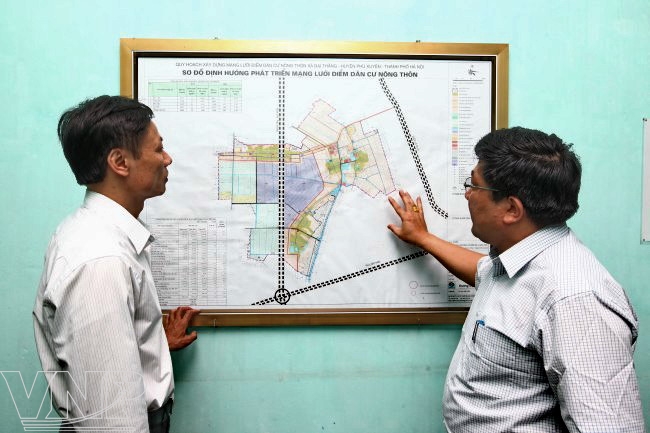
Pham Van Hung, Chairman of Dai Thang Commune People's Committee (right) in Phu Xuyen, Hanoi exchanges opinions with a commune cadre on the orientation of developing residential areas. Photo: Ngoc Ky
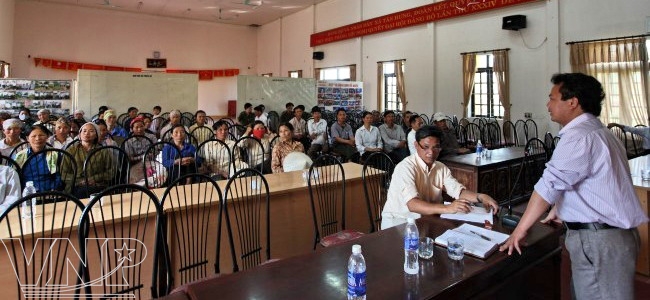
Nguyen Van Thu, Chairman of Tan Hung Commune People's Committee in Soc Son, Hanoi explains to the local farmers to help them understand the benefits of restructuring agricultural land. Photo: Ngoc Ky
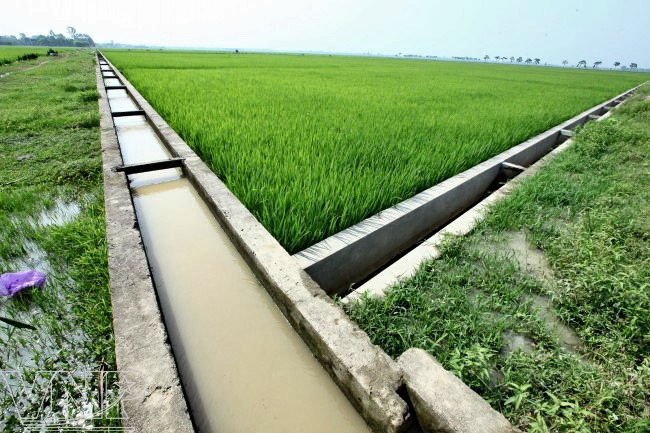
The successful implementation of agricultural land restructuring provides favourable conditions for rural planning and building irrigation canals. Photo: Ngoc Ky
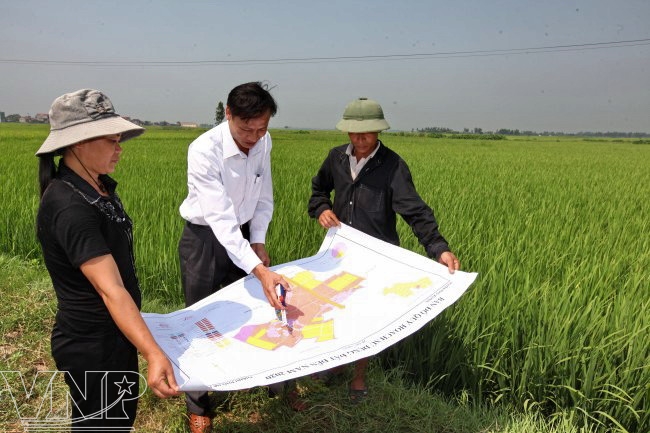
Ngo Van Tam, a cadre in Dai Thang Commune in Phu Xuyen, Hanoi instructs farmers on how to restructure cultivated land.
Photo: Ngoc Ky
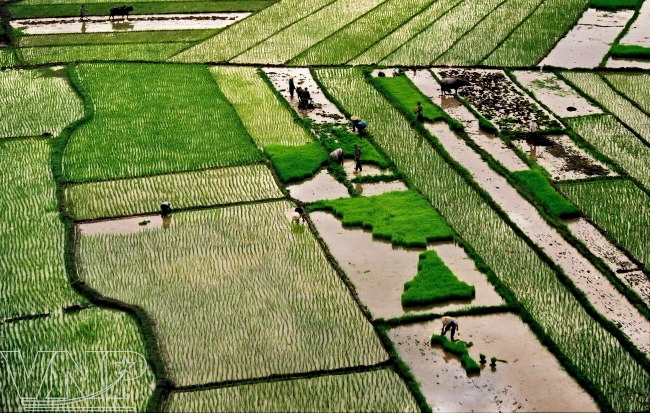
Cultivated land divided into small plots is not suitable for the current production because it limits the development of the agricultural sector. Photo: Trong Chinh |
Like Tan Hung Commune, it took nearly two years (from 2008 to late 2009) for Dai Thang Commune in Phu Xuyen District to complete the restructuring of agricultural land and each household has only one large plot for cultivating. Pham Van Hung, Chairman of Dai Thang Commune People’s Committee, said that the biggest difficulty in restructuring agricultural land was that the farmers wanted to retain traditional farming methods and they were worried about the injustice of re-dividing the land. On the other hand, the households who had rice paddies in a better geographical location did not support the programme. The commune had to mobilize, popularize and persuade the local farmers to support the programme as it relates directly to their interests. Furthermore, it also retained the ratio of land to person as regulated 1993, shifted the low fields into the areas for implementing the model incorporating a piece of land containing an orchard, a pond and an animal raising area, also known as the garden-pond-pigsty model abbreviated in Vietnamese as VAC. These cautious and suitable measures helped create a new face for the commune. At present, the commune has nearly 200ha of high quality rice production areas and 53ha of low agricultural land for the garden-pond-pigsty model. Thanks to the implementation of the programme and the shift of plant and animal structure, the income of local farmers has increased, reaching about 200-300 million VND/ha, after expenses.
According to Le Thiet Cuong, Head of Hanoi’s Rural Development Department, the successful implementation of the restructuring of agricultural land would increase the production value through programmes and projects on applying science, technique and mechanization to production. It would provide favourbale conditions for the locality to implement the rural planning, build basic facilities and reserve part of the redundant land for other purposes to mobilize resources for new rural development.
THE DETERMINATION OF HANOI’S AUTHORITY
Hanoi has 19 districts and towns with 401 communes and a total agricultural land of 93,556.8ha that need to be restructured. Aware of the benefits of land restructuring, in 1998 Hanoi People’s Committee issued documents on the production promotion based on turning small fields into larger ones together with the land use planning and granting farmers a land-use licence. However, the programme has not been implemented well in Hanoi with a high rate of households having 4-5 plots. On average, each household has 10-12 plots and there are those who have 30-40 plots, each covering 150m2 or only 5-7m2. The small scale fields have limited the development of the agricultural sector and have not encouraged farmers to invest in intensive cultivation and shift the plant structure. After 14 years, Hanoi has planned 36,202.59ha out of 93,556.8ha, reaching 38,70%.
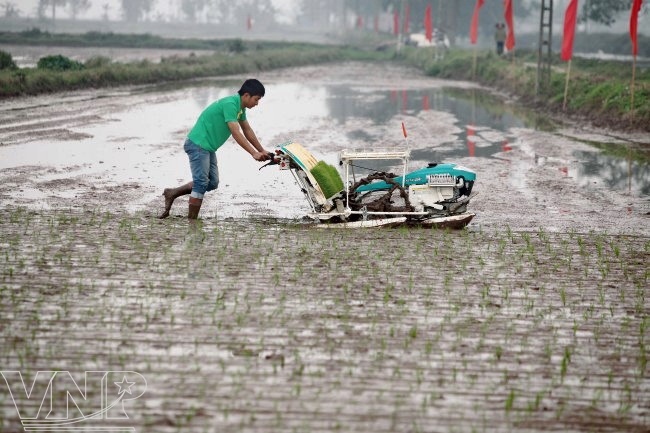
The successful implementation of agricultural land restructuring helps increase the area in one field, facilitating the farmers to apply mechanism to rice production. Photo: Ngoc Ky
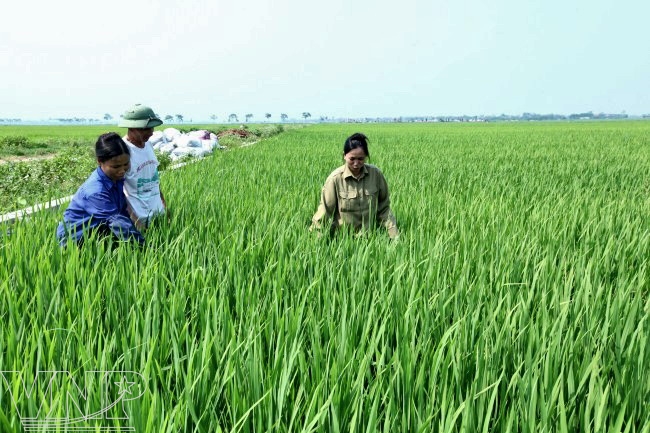
Farmers in Tan Hung, Soc Son, Hanoi check the quality of rice. Photo: Ngoc Ky
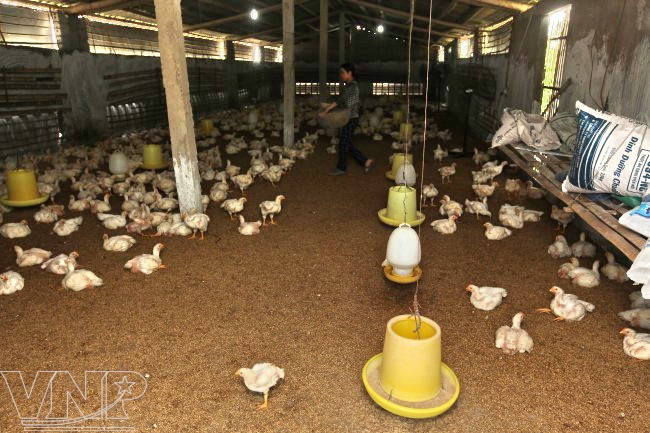
Thanks to agricultural land restructuring, the family of Nguyen Thi Huong in An My Village, Dai Thang Commune, Phu Xuyen District in Hanoi built a chicken raising farm which earns about 300-400 million VND per year. Photo: Ngoc Ky
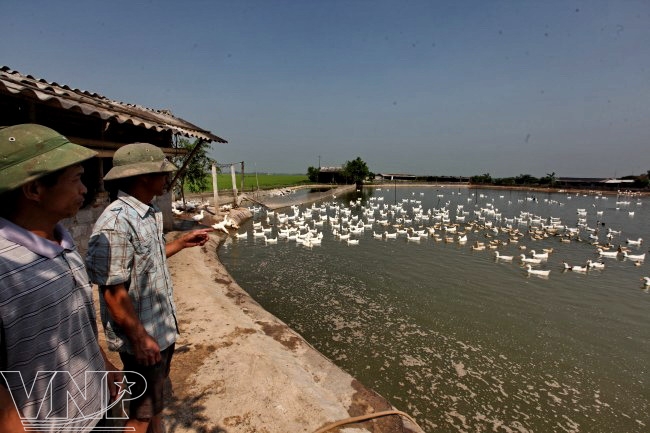
Dai Thang Commune in Phu Xuyen, Hanoi has successfully implemented cultivated land restructuring, turning 54ha of ineffective fields into an area for the garden-pond- pigsty model. Photo: Ngoc Ky |
Nguyen Cong Soai, Deputy Permanent Secretary of Hanoi Party’s Committee, Head of the Steering Board for Programme 02 on Agricultural Development and New Rural Construction and Improving the Living Standards of Local People in Hanoi, ordered to further boost the implementation of the programme and make sure that each household has only 1-2 large plots. In the future Hanoi should mobilize the whole political system to engage in the programme and continue mobilizing farmers in the localities that have carried out the movement well to apply advanced technique and mechanization to agricultural production and shift the plant structure. The relevant departments and sectors should build a mechanism to support the programme and build ditches and irrigation canals. When the restructuring of agricultural land is completed, Hanoi will focus on planning large scale fields. For the redundant land, Hanoi will research and invest in building infrastructure to serve agricultural production.
Story: Khanh Thu - Photos: Ngoc Ky - Trong Chinh